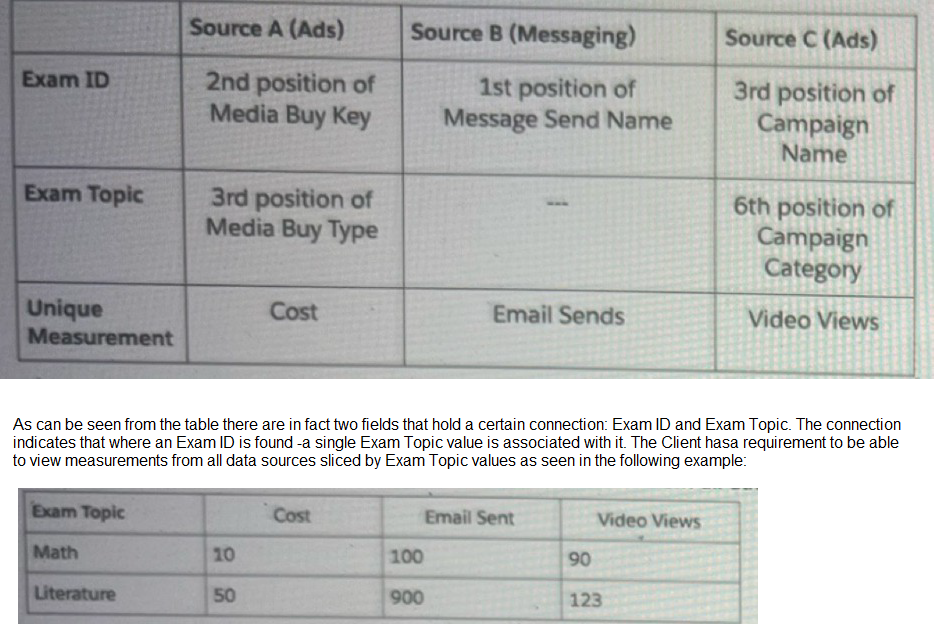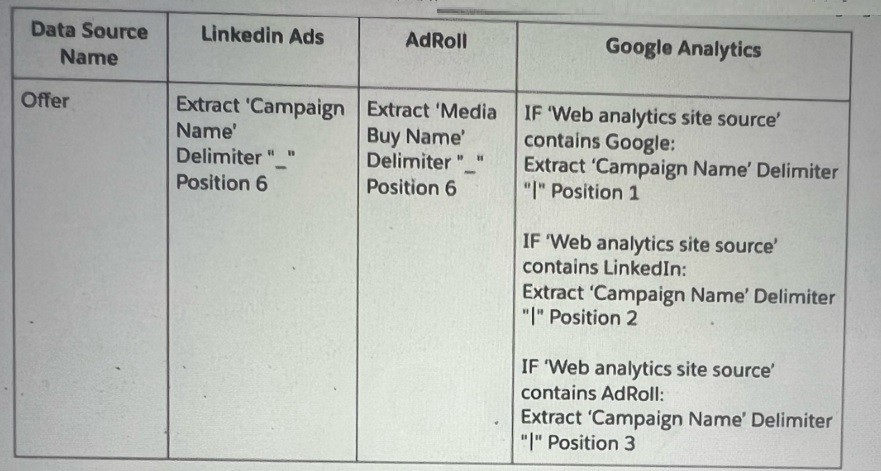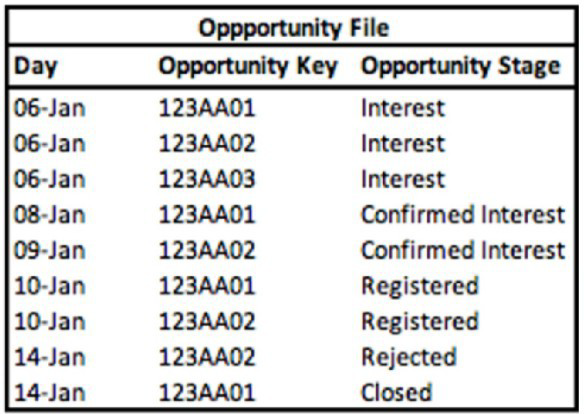
- Email support@dumps4free.com

Your client would like to create a new harmonization field - Exam Topic.
The below table represents the harmonization logic from each source.

Which harmonization feature should an Implementation engineer use to meet the client's requirement?
A. Transformers
B. Parent Chile
C. Fusion
D. Custom Classification
E. Calculated dimensions
Explanation: To meet the client's requirement of slicing measurements by 'Exam Topic' values, an Implementation Engineer should use Custom Classification. This feature allows different Exam IDs to be classified into their respective Exam Topics, ensuring that data from all sources can be accurately harmonized and analyzed based on these topics.
Which two statements are correct regarding variable Dimensions in marketing Cloud intelligence’s data model?
A. These dimensions are stored at the workspace level
B. Variable Dimensions hold a Many-to-Many relationship with its main entity
C. All variables exist in every data set type, hence are considered as overarching dimensions
D. These are stand alone dimensions that pertain to the data set itself rather than to a specific entity
Explanation: Variable dimensions in Marketing Cloud Intelligence's data model are flexible and can be associated with multiple entities, forming a many-to-many relationship. These dimensions are configured and stored at the workspace level, allowing for customization and alignment with specific reporting needs and analytics practices.
An Implementation engineer is requested to create anew harmonization field 'Offer’and apply the following logic:

The implementation engineer to use the Harmonization Center. Which of the below actions can help implement the new dimension ‘Offer?
A. Two separate patterns (filtered by Linkedin or AdRoll sources) Within Google Analytics' mapping A formula that reflects the logic above will be populated within a Web Analytics Site custom attribute Another pattern to be created for the newly Web Analytics Site custom attribute (filtered by Google Analytics source). A total of 3 patterns.
B. Two separate patterns (filtered by Linkedin or AdRoll sources) Within Google Analytics' mapping: A formula that reflects the logic above will be populated within a Campaign custom attribute. Another pattern to be created for the newly campaign attribute (filtered by Google Analytics source). A total of 3 patterns
C. Two separate patterns (filtered by Linkedin or AdRoll sources). Another single pattern for Campaign Name (filtered by Google Analytics source). A total of 3 patterns.
D. Two separate patterns (filtered by Linkedln or AdRoll sources). Another single pattern for Web Analytics Site Source (filtered by Google Analytics source), extracting all three positions A total of 3 patterns.
Explanation: To implement the new harmonization field 'Offer', the implementation engineer would create two separate harmonization patterns for LinkedIn and AdRoll sources, extracting the 'Campaign Name' using the specified delimiter and position. Then, within Google Analytics' mapping, a custom attribute for the 'Campaign' would be created to apply the formula logic based on the source. This allows for the harmonization of campaign data across different platforms, ensuring consistency in the reporting and analysis within Marketing Cloud Intelligence. The total patterns required would be three, one for each data source involved.
A technical architect is provided with the logic and Opportunity file shown below:
The opportunity status logic is as follows:
For the opportunity stages “Interest”, “Confirmed Interest” and “Registered”, the status should be “Open”.
For the opportunity stage “Closed”, the opportunity status should be closed Otherwise, return null for the opportunity status.

Given the above file and logic and assuming that the file is mapped in a generic data stream type with the following mapping
“Day” — Standard “Day” field
“Opportunity Key” > Main Generic Entity Key
“Opportunity Stage” + Generic Entity Key 2
A pivot table was created to present the count of opportunities in each stage. The pivot table is filtered on Jan 7th - 11th. Which option reflects the stage(s) the Opportunity key 123AA01 is associated with?
A. Registered
B. Interest & Registered
C. Confirmed Interest & Registered
D. Interest
E. Confirmed Interest
Explanation: Analyzing the Opportunity file with a filter set from January 7th to 11th, Opportunity Key '123AA01' appears under 'Interest' on January 6th and 8th, and under 'Registered' on January 10th. Therefore, during the specified date range, Opportunity Key '123AA01' is associated with both 'Interest' and 'Registered' stages. Salesforce Marketing Cloud Intelligence provides the capability to map and track opportunity stages over time, allowing for historical stage tracking and reporting. This answer aligns with the ability to use pivot tables to filter and display data by specific attributes and timeframes, as outlined in the Salesforce Marketing Cloud Intelligence documentation.
Which three entities and/or functions can be used in an expression when building a calculated dimension?
A. The VLOOKUP function
B. Mapped dimensions
C. The EXTRACT function
D. Calculated dimensions
E. Mapped measurements
Explanation: In the context of Marketing Cloud Intelligence, when building a calculated dimension, you can typically use:
B. Mapped dimensions: These are dimensions that have been brought into Marketing Cloud Intelligence through the data integration process and have been mapped to a known schema or model.
C. The EXTRACT function: This function can be used to dynamically create dimensions by extracting values from a mapped dimension or measurement.
E. Mapped measurements: Similar to mapped dimensions, these are quantitative data points that have been integrated into the platform and can be referenced in calculations.
Calculated dimensions (D) and the VLOOKUP function (A) are not typically used within the expression for a calculated dimension. Calculated dimensions are usually an output, not an input, and VLOOKUP is a function typically used to enrich or connect data, not within the definition of a calculated dimension itself.
| Page 1 out of 13 Pages |